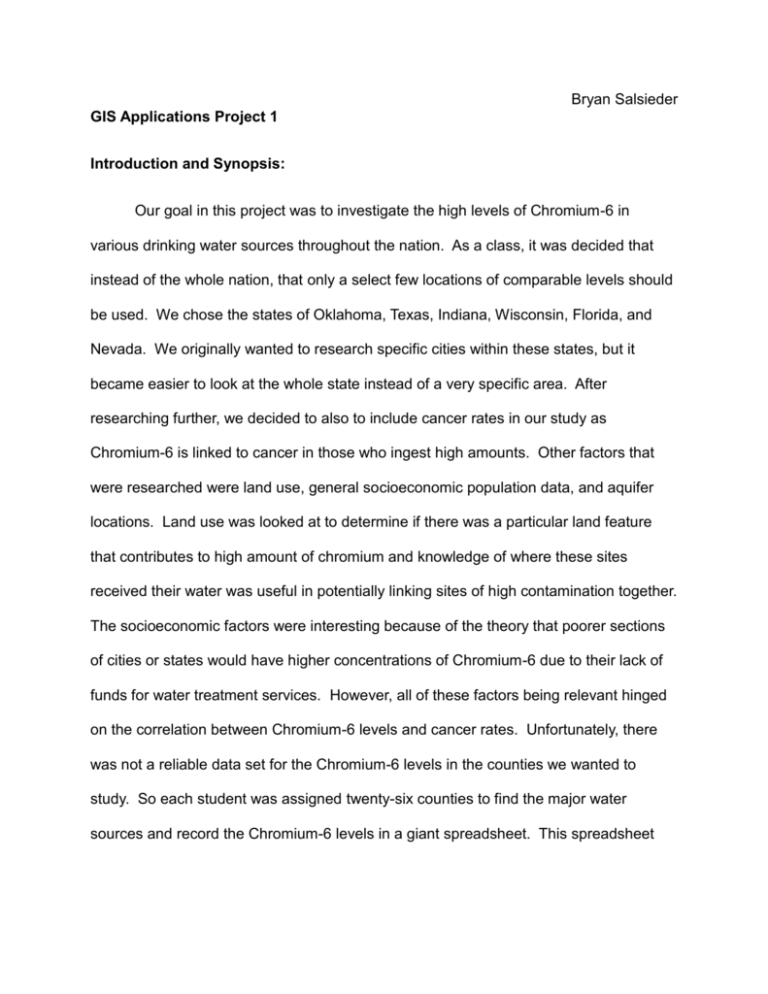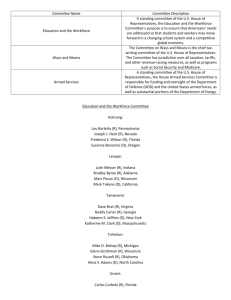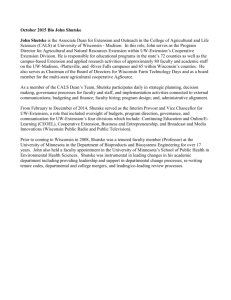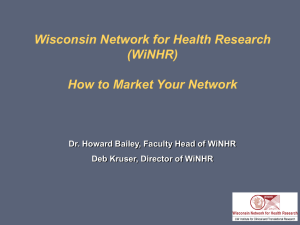Bryan Salsieder GIS Applications Project 1 Introduction and
advertisement

Bryan Salsieder GIS Applications Project 1 Introduction and Synopsis: Our goal in this project was to investigate the high levels of Chromium-6 in various drinking water sources throughout the nation. As a class, it was decided that instead of the whole nation, that only a select few locations of comparable levels should be used. We chose the states of Oklahoma, Texas, Indiana, Wisconsin, Florida, and Nevada. We originally wanted to research specific cities within these states, but it became easier to look at the whole state instead of a very specific area. After researching further, we decided to also to include cancer rates in our study as Chromium-6 is linked to cancer in those who ingest high amounts. Other factors that were researched were land use, general socioeconomic population data, and aquifer locations. Land use was looked at to determine if there was a particular land feature that contributes to high amount of chromium and knowledge of where these sites received their water was useful in potentially linking sites of high contamination together. The socioeconomic factors were interesting because of the theory that poorer sections of cities or states would have higher concentrations of Chromium-6 due to their lack of funds for water treatment services. However, all of these factors being relevant hinged on the correlation between Chromium-6 levels and cancer rates. Unfortunately, there was not a reliable data set for the Chromium-6 levels in the counties we wanted to study. So each student was assigned twenty-six counties to find the major water sources and record the Chromium-6 levels in a giant spreadsheet. This spreadsheet Bryan Salsieder was then available for all the counties for each state and this became essential in the group phase of this project. Individual Contribution: Every person in the class was assigned at least one variable to research from one of the six states, although many people chose two to effectively cover all the data. My personal contribution was the land use data for all of Wisconsin and the close up view of Madison and Dane County. I also attempted to contribute to the Reno, NV water sources, but found that someone else had also done the same research and I ceded that aspect of the project to them because I had the land use map to call my own. Finding data for Wisconsin was fairly easy through a quick internet search. I came across the state run natural resource website which had, for free, the entire land use data for the state in raster form. I simply downloaded it and combined a few attributes to reduce the amount of busy color on the display. Since the city of study in Wisconsin was Madison, I overlaid a shapefile of the Madison city limits, and using the Extract to Mask tool, I was able to clip down the raster to approximately the borders of Madison so the land use in the immediate area could be seen. For Reno, NV, I downloaded the necessary shapefiles from census.gov as well as the water bodies in the area. After some research through Reno's municipal sites, it was determined that Reno received its water from the Truckee River, the main river leading from Lake Tahoe further downstream. I made a shapefile that was just the Truckee River and highlighted it so it became apparent that it was the main river and water source flowing through Reno. Bryan Salsieder These two maps were then uploaded to the Wiki space online as everyone else has done. Group Work: Once all the data had been uploaded, groups were formed to cover a few research questions about the data. I partnered with Jacob Cantrell to determine the counties with the highest concentrations of Chromium-6 and the highest rate of cancer in the six states the class had selected. We also hoped to show that higher Chromium6 amounts correlate to a high rate of cancers. Although we were hoping for this, it was not the basis of our research; we only wanted to see what the top twenty counties over the entire six states, and then the top five in each state individually for both Chromium-6 levels and cancer rates. Although there were folders for the basic shapefiles of the six states, they were not all consistent with each other or not available, so our first step was to utilize the census.gov TIGER lines to download the outlines of the counties within the states and the United States state borders. The cancer rate data came from the public class folders where we found complete health data of all the rates we needed and the Chromium-6 data came from the compiled spreadsheet of everyone's researched data. However, one thing we noticed about the data sets was that there was no information for cancer rates in Nevada counties, only deaths from cancer. Nevada ended up being a persistent problem in this project due to it not being used for the cancer rate shapefile and its large county size giving the appearance of a larger area affected by high Chromium-6 on the map. Our initial idea for the display maps was to have one map for each state with the highest Chromium-6 counties and the highest cancer rate counties Bryan Salsieder being highlighted. However, the longer we thought about it, it ended up being too many maps to display properly and it was decided that one map of the United States with the various counties highlighted would be for the best. Initially we wanted to make the layers transparent, one being red and the other blue, so that counties that a more of a vivid purple would be the ones that had overlapping Chromium-6 levels and a high cancer rate. This idea did not work as well as we had hoped so instead we set the intervals in such a way that only the highest values would show up. We then overlaid these on one another to see if there was any overlap. Bryan Salsieder Results: The results were unexpected in that only one county had overlap of Chromium-6 levels and cancer rates. Otherwise, the top twenty counties were separate and at times far from each other. This was the exact opposite of what were looking for, which was a decent amount of the counties selected to have high levels of both Chromium-6 and cancer rates. This leads to the conclusion that perhaps a high rate of Chromium-6 does not significantly affect cancer rates overall. Group Dynamic: Since we have worked together previously throughout other classes, the group dynamic between Jacob and myself is effective and cooperative. We both found the pertinent data through the internet and our class folders. Most of my work was in the creation of the ArcMap document and the exported .jpeg that is seen above. Jacob dealt more with the Xcel spreadsheets and ordering the data to something useful and easily displayed. The table of values at the end of this document was his work with collaboration being only in the visuals of the table. Jacob was also the creator of the graphs found with the tables as well. We both worked on the project in class during the allotted time and out of class when our schedules allowed it. It was necessary to be collaborative with this project because of the amount of data that we decided to analyze and display. Overall, even if the resulting map did not produce the results we were hoping for, it still produced results that are valid. Bryan Salsieder Conclusion: As a first project in a class as open as this one is, I would say that it has been an overall success. Perhaps not in achieving the goal we initially set out to prove, but a success in that we learned how to work in a professional organized setting where individuals do their own work to contribute to the whole. We then broke into smaller groups to tackle smaller assigned tasks using the data set that we had created previously. Every group had their own research question and our group tried to show the top counties of Chromium-6 levels and cancer rates in hopes of showing some correlation between the two variables. We found that there was very little correlation, which is a perfectly viable result. Although Chromium-6 is a dangerous chemical and maybe causes a specific type of cancer, it has not been shown in this experiment to significantly impact overall cancer rates in our selected states of study. Bryan Salsieder County State County Florida Hamilton 7.686366 Florida Florida Madison 6.957542 Florida Florida Suwannee 6.408617 Florida Florida Sumter 4.914331 Florida Florida Martin 4.056983 Florida Indiana Marshall 15.65834 Indiana Indiana Ripley 14.27345 Indiana Indiana Fulton 12.70223 Indiana Indiana Union 9.593456 Indiana Indiana Warren 6.407189 Indiana Nevada Washoe 9.813911 Nevada Nevada White Pine 4.439409 Nevada Nevada Elko 3.933027 Nevada Nevada Carson City 2.884347 Nevada Nevada Clark 2.26756 Nevada Oklahom a Oklahom a Oklahom a Oklahom a Oklahom a Texas Cleveland 29.51448 Oklahoma McClain 3.847614 Oklahoma Canadian 3.450701 Oklahoma Oklahoma 1.77013 Oklahoma 1.676133 Oklahoma Texas Kleberg Ellis Hudspeth Chromium State 20.2638 Texas 10.03307 Texas Cancer Rates Union County Sumter County Lake County 1.2364 Marion County Polk County 0.5165 Benton County Blackford County Clark County Vigo County 0.5437 Fulton County Nye County 0.5116 Churchill County Carson City 0.0674 Lyon County Lincoln County Pawnee County Choctaw County Kay County 0.0664 Murray County Garvin County Anderson County Andrews County 0.5379 0.5568 0.5243 0.506 0.5249 0.5151 0.5142 0.0727 0.0674 0.063 0.5881 0.5632 0.5386 0.5368 0.4506 0.4784 Bryan Salsieder Texas Duval 7.534914 Texas Texas Armstrong 5.925155 Texas Texas Hansford 5.854986 Texas Wisconsin Winnebago 8.073484 Wisconsin Wisconsin Washington 7.976221 Wisconsin Wisconsin Richland 6.599101 Wisconsin Wisconsin Sheboygan 3.658314 Wisconsin Wisconsin Waushara 2.357122 Wisconsin Angelina County Aransas County Archer County Menomine e County Marquette County Oneida County Crawford County Door County Table 1: Top 5 Counties in respect to Chromium-6 levels and Cancer Rates 35 30 25 Florida Chromium Indiana Chromium 20 Nevada Chromium 15 Oklahoma Chromium Texas Chromium 10 Wisconsin Chromium 5 0 0 1 2 3 4 5 6 Figure 1: Chromium-6 Levels as a Percentage of Total State Levels 0.5002 0.4867 0.4328 0.6316 0.6004 0.544 0.5388 0.5265 Bryan Salsieder 1.4 1.2 Florida 1 Indiana 0.8 Nevada 0.6 Oklahoma 0.4 Texas Wisconsin 0.2 0 0 1 2 3 Figure 2: Cancer Rates in the Selected Counties 4 5 6







